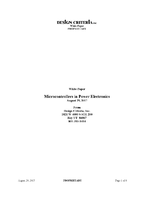PEX Tubing at University of Chicago wins industry award.
Press Release Summary:
Plastics Pipe Institute announces industry award for PEX tubing used for cooling and heating new buildings at University of Chicago. The 360,000 sq-ft North Campus Residence Hall and Dining Commons won the award. Project highlights include smart way of heating and cooling and activation of dome circuits. These buildings consist of 6, 11, and 15 floors and accommodate nearly 800 undergraduate students.
Original Press Release:
Smarter Building Leads to Top Industry Award
Radiant Heating and Cooling System in New University Complex Help to Meet Aggressive Energy Saving Goals
The miles of PEX tubing used to heat and cool new buildings at the University of Chicago not only provided a state-of-the-art system, it also won a top industry award for the project. The 360,000-square-foot North Campus Residence Hall and Dining Commons earned the Project of the Year Award from the Plastics Pipe Institute, Inc. (PPI) for PPI member company REHAU Construction, LLC. PPI is the major trade association representing all segments of the plastic pipe industry. Submissions for the Project of the Year are voted upon by PPI members and winners are selected based on significant attributes and contributions to the industry as showcased in the project and its achievements. At the university, more than 300,000 linear feet of REHAU RAUPEX tubing, along with other components such as 183 distribution manifolds, were used for the radiant heating and cooling systems in floors and ceilings.
One of the highly beneficial aspects of the project is the 'smart' way the heating and cooling systems are controlled. The dorm circuits are activated as “banks” differentiating north- and south-facing exposures. Circuit actuators are connected to window relays in each dorm room. If a window is left open, the circuit(s) for that room will close, shutting down the system and saving energy.
"This project is providing a prominent demonstration of the energy efficiency, comfort, reliability and environmental benefits of products represented by PPI’s Building and Construction Division (BCD)," stated Tony Radoszewski, CAE, president of PPI.
"This is an excellent application of PEX-based radiant heating/cooling hybrid technology. We know that others in the industry will benefit by learning from this Project of the Year winner. It is an example for architects and engineers of what can be accomplished with a PEX radiant heating/cooling hybrid system."
The three-building project, with towers of 6, 11 and 15 floors, houses approximately 800 undergraduate students and opened in September 2016. The new complex replaced the Pierce Tower Residence Hall and Dining Commons, which housed students for more than 50 years before it was demolished in 2013. When planning began, school administrators had a goal to create a modern, energy-efficient structure that would bridge the academic community with the surrounding neighborhood of Hyde Park.
Kevin Rodgers, the university’s campus energy manager, worked with energy specialists at the National Renewable Energy Laboratory (NREL) to set an aggressive annual energy usage intensity (EUI) target of 56.6 kBtu/ft2 for the new residence hall. EUI is defined as the total amount of energy used by a building during a year divided by its total gross floor area. The University of Chicago has pursued energy efficiency across its campus for years, but Rodgers said this is the first building project to include a specific energy goal as part of the RFP.
Compared to the average residence hall usage in Chicago, this EUI represents a 41 percent reduction, eliminating 1,920 metric tons of CO2 emissions per year. Rodgers indicated that the old Pierce Hall had an annual EUI of 150 kBtu/ft2, nearly three times the target for the new structure, while the average university residence hall building in Chicago had an EUI of 96.6 kBtu/ft2 a year in 2016, based on real data provided by five area universities.
Unique Design Meets Energy Targets
Architectural firm Studio Gang Architects (Chicago) and general contractor M. A. Mortenson Construction (Minneapolis, MN) were awarded the design-build partnership.
“There were some concerns going in that the aggressive energy goals we established would result in rectangle boxes instead of architecturally significant buildings,” Rodgers said. “That ended up being false. The four finalists all had very unique designs that met our energy requirements.” The team targeted USGBC LEED® Gold certification, a measure of the sustainability and efficiency of the design.
The building’s common areas are heated via a traditional forced-air system, while the student living quarters use REHAU in-slab hydronic radiant heating and cooling. Todd Zima, design principal at Studio Gang, said the radiant heating and cooling system was chosen early in the project for the dorm rooms in order to improve energy efficiency and enhance comfort for the students. By circulating heated or chilled water through 5/8-inch PEX tubing installed at six-inch spacing in the ceilings on each floor, the hydronic system maintains the spaces at even, comfortable temperatures while using less energy than traditional forced-air systems. Another ability of the PEX-based system was to provide independent zones. The zoning was divided by manifolds, whose circuits were divided into north- versus south-facing spaces. REHAU’s actuators were utilized on the manifolds, but rather than being connected to thermostats, as typically seen in hydronic radiant projects, they were connected to window sensors so that the radiant system could be shut off in cooling mode if the operable windows were opened by occupants. This design strategy was incorporated to avoid any undesirable condensation from occurring.
“To include radiant cooling in a project of this size in this climate for a residential structure was something we hadn’t seen,” Zima explained. "Sharing the capabilities of the REHAU radiant system with Mortenson and university officials convinced them it was the way to go."
Energy targets were not the only ambitious component of the project. Mortenson set an aggressive construction schedule to have the residence hall ready by the start of the 2016-2017 school year. Installing 300,000 feet of radiant heating and cooling pipe at the pace required to meet Mortenson’s schedule required some ingenuity.
Ryan Blackman, project manager at Chicago-based Mechanical Inc., said participation by his company and REHAU early in the planning stages helped them meet tight deadlines that would come later. Blackman’s team worked with engineering firm dbHMS (Chicago) and Studio Gang a year before construction began to “determine how the building would actually be built.”
Partnering early led the team to preassemble each room’s radiant heating/cooling tubing system on wire mesh on the ground. A floor’s worth of mats was then stacked and lifted by crane on a custom-built platform to each tower for speedy installation.
“We thought outside the box a fair amount, and, to be honest, we surprised ourselves,” Blackman offered. “The first couple of floors were a bit of a learning curve, but once we got into a groove of the entire fabrication process, we were able to meet Mortenson’s schedule and put in a quality product. It ended up going very well.”
Blackman credited REHAU team members for their flexibility and innovative ideas. “I can’t tell you how many conference calls and site visits we had. They were great. They went through a lot of revisions, both for design issues, as well as constructability issues,” he stated.
“We brought them in early because they had been working with dbHMS on how everything was going to be laid out. Then, we brought them in to consult on how the system would come together and what the construction limits were. A lot of times, when we don’t have an opportunity to participate so early in the development of a project, which means that sometimes things get drawn up that we, as contractors, can’t make work. Our front-end work on this project kept us from holding up construction on the job."
Pre-fabricated PEX tubing circuits and manifolds stations were assembled on-site in centralized locations in order to reduce the installation time and keep up with floor-by-floor construction. This also reduced the interference of multiple trades on the same floor by keeping the radiant circuit construction off the floor until completely ready for installation.
Echoing Blackman's comments, Lance MacNevin, P. Eng. director of engineering for the PPI division said, "Each year, Building and Construction Division members such as REHAU submit innovative projects for our annual award. This year’s winning project has been well-documented as an example for others. It is an excellent case study that demonstrates the advantages of hydronic radiant and cooling systems for large-scale residential applications that, provide a very comfortable environment with maximum efficiency and proven to support healthy indoor air quality. The ability of the design and construction teams to streamline their installation technique to speed installation of the PEX tubing is another huge success for this project."
For additional information, go to the Plastics Pipe Institute's website at: www.plasticpipe.org.
About PPI:
The Plastics Pipe Institute, Inc. (PPI) is the major North American trade association representing all segments of the plastic pipe industry and is dedicated to promoting plastic as the materials of choice for pipe and conduit applications. PPI is the premier technical, engineering and industry knowledge resource publishing data for use in the development and design of plastic pipe and conduit systems. Additionally, PPI collaborates with industry organizations that set standards for manufacturing practices and installation methods.




